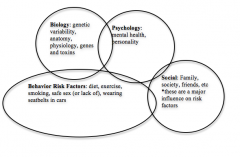![]()
![]()
![]()
Use LEFT and RIGHT arrow keys to navigate between flashcards;
Use UP and DOWN arrow keys to flip the card;
H to show hint;
A reads text to speech;
17 Cards in this Set
- Front
- Back
|
morbidity
|
number of people living with a disease or illness. (number of cases of a disease at a point in time) Distinguished in terms of incidence and prevalence
|
|
|
Incidence
|
number of new cases
|
|
|
Prevalence
|
total number of existing cases
|
|
|
mortality
|
number of deaths due to a particular cause
|
|
|
chronic
|
Time dependent. Slowly developing and/or long-lasting illness/disease. Can be treated or cured (ex: asthma, arthritis, heart disease, cancer, Alzheimer’s, HIV, AIDS)
|
|
|
acute
|
disease leaves in a short time. Short term course of illness—less than 6 weeks. (ex. Cold and other viruses, injuries)
|
|
|
etiology
|
the origins/cause of a disease/illness
|
|
|
epidemiology
|
The course that a disease/illness takes (patterns, causes, effects)
|
|
|
dependence
|
Adaptation of homeostatic physiological state as a result of high drug intake.
|
|
|
dose-dependent relationship
|
for every one unit that the x increases, so does y
|
|
|
agonist
|
Promotes (increases) activity
|
|
|
antagonist
|
Blocks, decreases activity
|
|
|
homeostatic adaptations
|
“neuro-adaptations”—compensatory physiological responses to excessive stimulation. Reversible post-cessation
|
|
|
associative learning
|
Brain specific mechanism. Remodels important experiences. Can be permanent. Addictive drugs may usurp Associative learning.
|
|
|
Tolerance
|
Frequently used drug has less effect, must be used more (higher does) May result in higher and more frequent dosage for same impact.
|
|
|
inverted U-shaped arousal curve
|
Important for persuasion/getting attention. A moderate amount of arousal is best. Persuade people with a certain message for maximum impact.
|
|
|
biopsychosocial model
|

|

